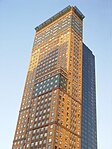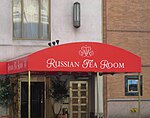Carnegie Hall

Carnegie Hall ( KAR-nə-ghee) is a concert venue in Midtown Manhattan in New York City. It is at 881 Seventh Avenue, occupying the east side of Seventh Avenue between West 56th and 57th Streets. Designed by architect William Burnet Tuthill and built by philanthropist Andrew Carnegie, it is one of the most prestigious venues in the world for both classical music and popular music. Carnegie Hall has its own artistic programming, development, and marketing departments and presents about 250 performances each season. It is also rented out to performing groups. Carnegie Hall has 3,671 seats, divided among three auditoriums. The largest one is the Stern Auditorium, a five-story auditorium with 2,804 seats. Also part of the complex are the 599-seat Zankel Hall on Seventh Avenue, as well as the 268-seat Joan and Sanford I. Weill Recital Hall on 57th Street. Besides the auditoriums, Carnegie Hall contains offices on its top stories. Carnegie Hall, originally the Music Hall, was constructed between 1889 and 1891 as a venue shared by the Oratorio Society of New York and the New York Symphony Society. The hall was owned by the Carnegie family until 1925, after which Robert E. Simon and then his son, Robert E. Simon, Jr., became owner. Carnegie Hall was proposed for demolition in the 1950s in advance of the New York Philharmonic relocating to Lincoln Center in 1962. Though Carnegie Hall is designated a National Historic Landmark and protected by the New York City Landmarks Preservation Commission, it has not had a resident company since the New York Philharmonic moved out. Carnegie Hall was renovated multiple times throughout its history, including in the 1940s and 1980s.
Excerpt from the Wikipedia article Carnegie Hall (License: CC BY-SA 3.0, Authors, Images).Carnegie Hall
7th Avenue, New York Manhattan
Geographical coordinates (GPS) Address Phone number Website External links Nearby Places Show on map
Geographical coordinates (GPS)
| Latitude | Longitude |
|---|---|
| N 40.765 ° | E -73.98 ° |
Address
Carnegie Hall
7th Avenue
10019 New York, Manhattan
New York, United States
Open on Google Maps







